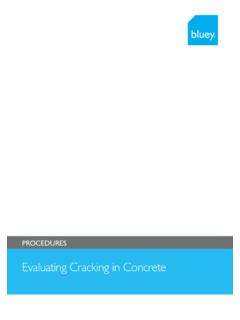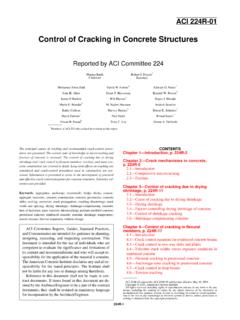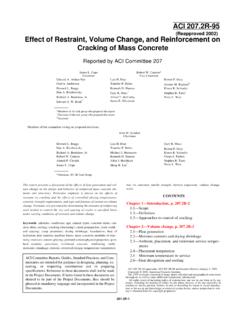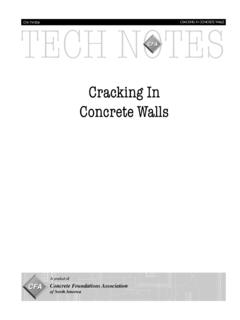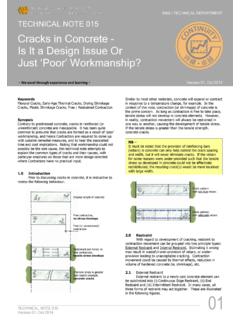Transcription of Concrete Defects – Causes and Remedies
1 Concrete Defects Causes and RemediesByM. Al Nasra, PhD, PE9/25/20081 Concrete Methods and Principles, (c) Al NasraCrackingCracking may result from one or more of the following:1.) Restraint: Restraint of movements brought about by drying shrinkage or thermal contraction due to poor practice such as:a.) Contraction joints/construction joints are too far apartb.) Contraction joints are not deep enough (1/4 slab depth)c.) Slabs are strongly restrained at perimetersd.) No isolated joints around columnse.) No joint at re-entrant anglesf.) Low strength, high w/c ratiog.) Deficient curingh.) Bonding to subterranean structures such as footing pads9/25/20082 Concrete Methods and Principles, (c) Al NasraCracking (continued)2.) Uneven support by a poorly prepared sub-grade, poor drainage, or uneven support due to curling3.) Expansive clay in the ) Sulfates in sub-grade moisture5.
2 Placing Concrete over preformed joint filler6.) Improper jointing and sealing7.) Structural ) Impact9.) Disruption from alkali-silica reaction10.) Disruption from corrosion of reinforcing steel11.) Freezing and thawing along edges and at corners12.) Earth movement from contiguous Methods and Principles, (c) Al NasraCrazing and Map cracking Crazing is the development of a network of fine random cracks or fissures on the surface of Concrete or mortar due to shrinkage of the surface layer. Crazing cracks are shallow (rarely deeper than 3 mm). No significant effect on wear resistance or durability, but mainly unsightly9/25/20084 Concrete Methods and Principles, (c) Al NasraCrazing and Map Cracking9/25/20085 Concrete Methods and Principles, (c) Al NasraCauses of Crazinga.) poor or inadequate curingb.) Too wet mix, excessive floating, or excessive paste and fines at the surfacec.
3 Finishing while there is bleed water on the surfaced.) Sprinkling cement on the surface to dry up the bleed watere.) Carbonation chemical reaction between cement and carbon monoxide, or Methods and Principles, (c) Al NasraTo Prevent Crazing Start curing as soon as possible Use moderate slump Reduce the effect of water absorption by the sub-grade DO NOT Sprinkle or trowel dry cement or cement with fine sand Sprinkle water to facilitate finishing Perform finishing operation while bleed water is present Overwork or over finish the surface Cure with water much colder than the Concrete Allow alternates wetting and drying at early age Over use jitterbugs, vibrating screeds and bull-floats Allow too much clay and dirt in aggregates9/25/20087 Concrete Methods and Principles, (c) Al NasraDusting- Causes Overly wet mixes Floating and troweling bleed water into the surface Clay, dirt, and organic materials in the aggregate Use of dry cement shakes to dry the surface for earlier finishing Water applied to the surface by finishers Uneven heaters for cold weather protection Inadequate curing, especially in dry weather Inadequate ventilation in enclosed spaces Inadequate protection of the fresh Concrete from rain, snow, or drying Methods and Principles, (c) Al NasraDusting -Repair Sandblast, shot blast or use a high-pressure washer to remove the weak surface layer Eliminate dusting by applying hardeners, such as sodium silicate (water glass), or epoxy sealers, or cement paint.
4 In sever cases, place a topping course on durable substrate Concrete (may use wet grinding). 9/25/20089 Concrete Methods and Principles, (c) Al NasraScaling Scaling is a scabrous condition of some surface after exposure to freezing and thawing, in other words, local flaking or peeling of a finished surface of hardened Concrete as a result of freezing and thawing. The depth of scaling is usually less than 3 Methods and Principles, (c) Al NasraScaling - Causes The use of non-air-entrained Concrete or too little entrained air. Application of excessive amounts of calcium or sodium chloride deicing salts on Concrete with inadequate strength, air entrainment, or curing. Any finishing operation while bleed water is on the surface. Consequently, overworking the surface will result in high w/c ratio, low strength, and reduction in air content. Insufficient curing, results in weak surface skin Inadequate thermal protection allowing freezing and thawing at a very early age.
5 Causes of blistering that increase vulnerability to scaling9/25/200811 Concrete Methods and Principles, (c) Al NasraScaling -Repair Prepare the top surface. The top surface must be clean, sound, rough, and textures surface. Apply a thin bonded resurfacing Use portland cement Concrete resurfacing Use latex modified Concrete resurfacing Use polymer-modified cementitious-based repair mortar9/25/200812 Concrete Methods and Principles, (c) Al NasraPopouts Popouts are roughly cone-shaped pits in the surface of flatwork after a small piece of Concrete has broken away by internal pressure. This pressure is due to expansion, or chemical change9/25/200813 Concrete Methods and Principles, (c) Al NasraPopouts Popout holes range from 10 to 50 mm or more in diameter Popouts usually do not diminish the integrity of Concrete flat work Popouts are usually unsightly9/25/200814 Concrete Methods and Principles, (c) Al NasraPopouts Protective Measures Switching to a non-offending source of aggregate for flatwork, if possible Two-course construction, using selected of imported aggregate without popout potential for the top course Prohibiting application of impervious layers which aggravate popout problem Using low slump to prevent potential popout-causing particle from Methods and Principles, (c) Al NasraBlisters Blisters are hollow, low-profile bumps on Concrete surface.
6 Blisters occur whenever the surface does not allow water/air to escape into the Methods and Principles, (c) Al NasraBlisters - Causes Sticky Concrete mix due to excessive entrained air, poor aggregate gradation, or excessive fines Excessive fines brought to the surface due to; high slum, over-vibration, over-screeding, excessive bull floating, or improper floating. Job or climate conditions due to, rapid drying or setting, slow setting of the Concrete below the surface, too early finishing, or the sub-grade is cooler than the Methods and Principles, (c) Al NasraSpalling Unlike scaling and blistering, spalling is a deeper penetration of the slab. It may seriously impair the strength or serviceability of the slab. 9/25/200818 Concrete Methods and Principles, (c) Al NasraSpalling - Causes Insufficient depth of cover over reinforcement. Inferior mortar and Concrete in the cover over reinforcing steel due to over-wet Concrete , loss of entrained air, inadequate curing, excessive bleeding, improper jointing and sealing, or sever map cracking Poor bonding of two-course floors due to; inferior quality of surface Concrete in the base course, unremoved contamination, differences in shrinkage, drying of the bonding grout before the top course is placed, or excessive pressure developed at Methods and Principles, (c) Al NasraCracks in Concrete Basement Walls - Causes Temperature and drying shrinkage cracks Settlement cracks due to non-uniform support or expansive soil.
7 Structural cracks due to backfill and heavy equipment use in the fill process too close to the walls Lack of joints or improper jointing Methods and Principles, (c) Al Nasra9/25/200821 Concrete Methods and Principles, (c) Al Nasra9/25/200822 Concrete Methods and Principles, (c) Al NasraCracks in Concrete Basement Walls -Prevention Uniform soil support is provided Concrete is placed at a moderate slump, no excessive water added at the job site. Proper construction practices are followed in terms of drop height, formwork, waterproofing, drainage ..etc. Control joints are provided every 20 to 30 ft Backfilling is done carefully Proper curing practices are followed 9/25/200823 Concrete Methods and Principles, (c) Al Nasra



